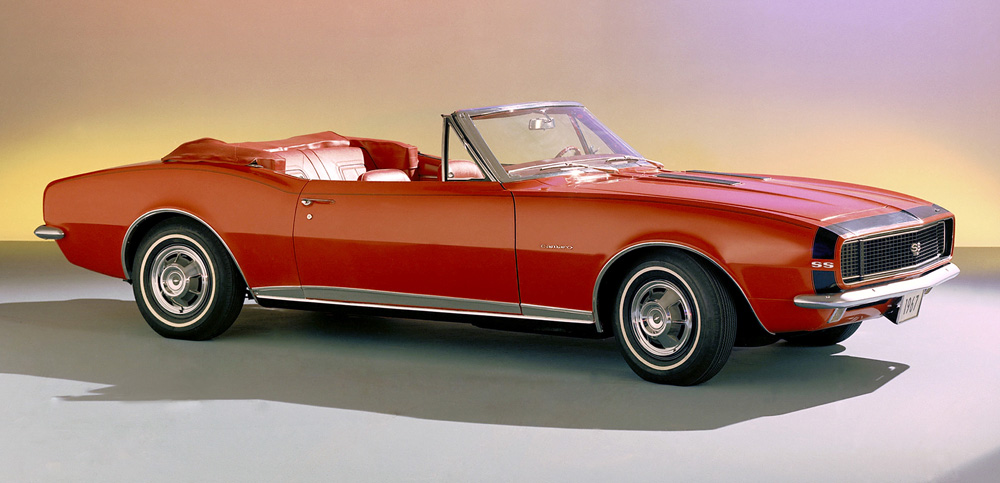
1967–1969 Chevrolet Camaro : First generation
- First generation: Production 1967–1969
- Model years; 1967–1969
- Body style; 2-door coupé and convertible
- Assembly; Van Nuys, California and Norwood, Ohio
- First-generation Camaro debuted in September 1966, for the 1967 model year, up to 1969 on a new rear-wheel drive GM F-body platform and would be available as a 2-door, 2+2 seating, coupe or convertible with a choice of 250 cu in (4.1 L) inline-6 and 302 cu in (4.9 L), 307 cu in (5.0 L), 327 cu in (5.4 L), 350 cu in (5.7 L), or 396 cu in (6.5 L) V8 powerplants.
- Production numbers:
- 1967; RS: 64,842 — SS: 34,411 — Z28: 1,002 — Total: 221,306
- 1968; RS: 40,977 — SS: 27,884 — Z28: 7,199 — Total: 235,147
- 1969; RS: 37,773 — SS: 34,932 — Z28: 20,302 — Total: 243,085

1967 Camaro were available with three packages, RS,SS and Z28.
Camaro RS
- Camaro RS was an appearance package that included hidden headlights, revised taillights, RS badging, wing windows, and exterior rocker trim.
Camaro SS
- Camaro SS included a 350 cu in (5.7 L) V8 engine and the L35 and L78 396 cu in (6.5 L) big-block V8’s were also available. The SS featured non-functional air inlets on the hood, special striping and SS badging on the grille, front fenders, gas cap, and horn button. It was possible to order both the SS and RS to receive a Camaro RS/SS. In 1967, a Camaro RS/SS convertible with a 396 engine paced the Indianapolis 500.
Camaro Z/28
- Z/28 was introduced in 1966 for the 1967 model year. It was the brainchild of Vince Piggins, who conceived offering “virtually race-ready” Camaros for sale from any Chevrolet dealer. The Z/28 option required power front disc brakes and a Muncie 4-speed manual transmission. It featured a 302 cu in (4.9 L) small-block V-8 engine, 3″ crankshaft with 4″ bore, an aluminum intake manifold, and a 4-barrel vacuum secondary Holley carburetor of 780 cfm. The engine was designed specifically to race in the Trans Am series (which required engines smaller than 305 cu in (5.0 L) and public availability of the car. Chevrolet wanted to keep the horsepower rating at less than 1 hp per cubic inch, for various reasons (e.g. insurance and racing classes). The factory rating of 290 hp occurred at 5300 rpm, while actual peak for the high-revving 302 was closer to 360 hp (268 kW) (with the single four barrel carb) and 400 hp (298 kW) (with optional dual-four barrel carbs) at 6800-7000 rpm. The Z/28 also came with upgraded suspension, racing stripes on the hood and trunk lid, ‘302’ front fender emblems on the early cars, and ‘Z/28’ emblems in late 68 & 69. It was also possible to combine the Z/28 package with the RS package. Only 602 Z/28s were sold in 1967, along with approximately 100 Indianapolis Pace Car replicas. The 1967 and 1968 Z/28s did not have the cowl induction hood, optional on the 1969 Z/28s. The 1967 Z28 received air from an open element air cleaner or from an optional cowl plenum duct attached to the side of the air cleaner that ran to the firewall and got air from the cowl vents. 15-inch rally wheels, were included with Z/28s had while all other 1967-9 Camaros had 14-inch wheels. The origin of the Z/28 nameplate came from the RPO codes – RPO Z27 was for the Super Sport package, and RPO Z28, at the time, was the code for a Special Performance Package. The Camaro’s standard drivetrain was a 230 cu in (3.8 L) straight-6 engine rated at 140 hp (104 kW) and backed by a Saginaw three-speed manual transmission. A four-speed manual was also available. The two-speed “Powerglide” automatic transmission was a popular option in 1967 and 1968 until the three-speed “Turbo Hydra-Matic 350” replaced it starting in 1969. The larger Turbo 400 three-speed was an option on L35 SS396 cars.
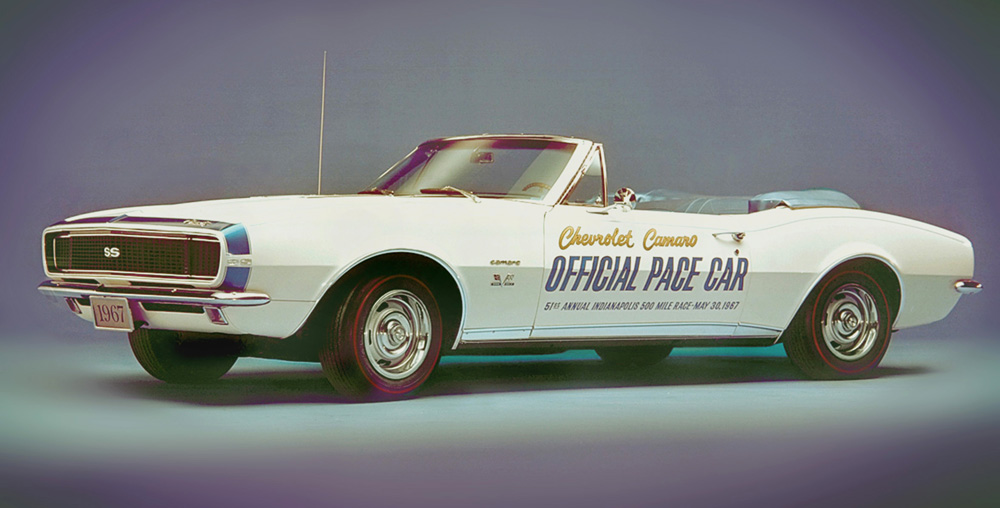
1967 Camaro Convertible
Chevy had more surprises in store as the decade wore on. “Pony cars” were ready to take on the world, and Chevy revealed its contender in September 1966. The public’s appetite had been whetted weeks before by teaser print advertisements that depicted the Camaro headlamps and honeycomb grille coming from a black background, with a single word – Camaro.
As the first new GM design born out of wind tunnel testing, Camaro offered a sleeker, more aerodynamic shape than its boxier rival, Mustang. Its long hood and abbreviated deckline gave it a unique look, and with a Sport Coupe, Convertible, Rally Sport, SS package and scores of options to choose from, buyers could literally personalize Camaro to their own tastes.
Camaro (derived from a French word meaning “companion”) was an instant hit. In a 2.2 million car year, ten percent of the Chevy 1967 model sales were Camaros. It symbolized youth to America … and young America showed its approval.
The famed Z28 badge (a name taken from its original option code that thrives today) arrived in January 1967, a spin-off created by Chevy performance engineer Vince Piggins. He believed Camaro could assert itself in the SCCA’s Trans Am Sedan class, and constructed a 302cid V8 that qualified the car for competition (305cid was the limit). The “Z” responded by winning the Trans Am championship for 2.0 liters and above in 1968 and 1969.
The public caught hold of the Z28, and wouldn’t let go. With 15-inch Corvette wheels, a heavy-duty suspension, power front disc brakes and special broad stripes, Z28 was a mover … and Chevrolet couldn’t keep up with demand.
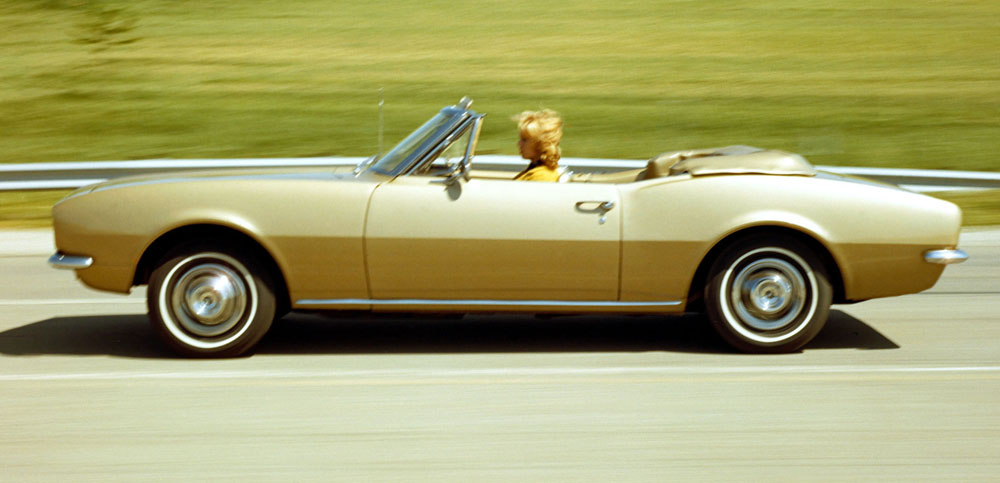

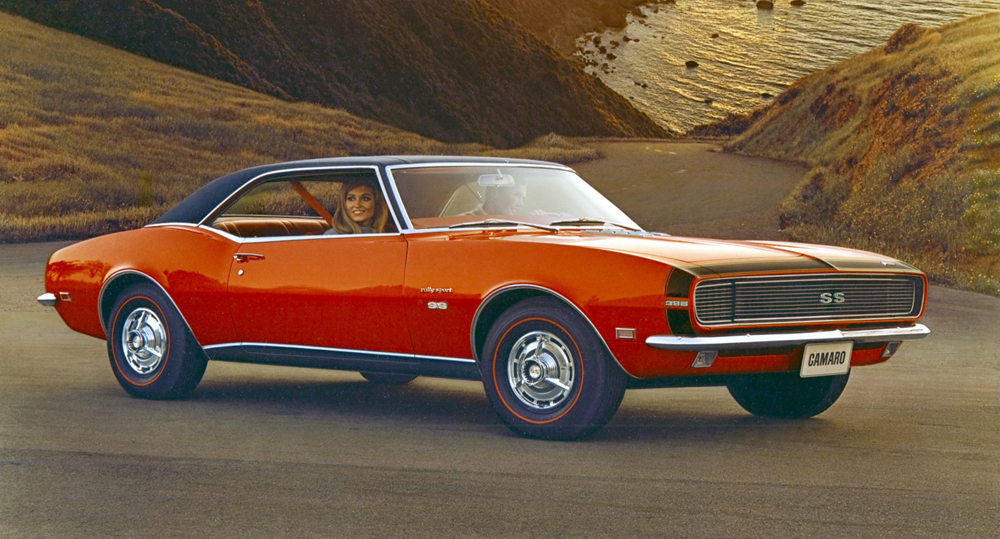
1968 Camaro
1968 Camarosaw the deletion of the side vent windows and the introduction of Astro Ventilation, a fresh-air-inlet system. Also added were side marker lights on the front fenders which was a government requirement for all 68 vehicles, a more pointed front grille, a front spoiler, and divided rear taillights. The front running lights (on non-RS models) were also changed from circular to oval. The big block SS models received chrome hood inserts that imitated velocity stacks. The shock absorber mounting was staggered to resolve wheel hop issues and higher performance models received multi-leaf rear springs instead of single-leaf units. A 396 cu in (6.5 L) 350 hp (261 kW) big block engine was added as an option for the SS, and the Z28 appeared in Camaro brochures. The 427 cu in (7.0 l) was not available as a Regular Production Option (RPO). Several specialty after-market dealers, such as Baldwin-Motion Performance Combine, Long Island, NY, offered the 427 as a replacement for the factory-supplied 396 cid engine. 7,199 Z28s were sold in 1968.
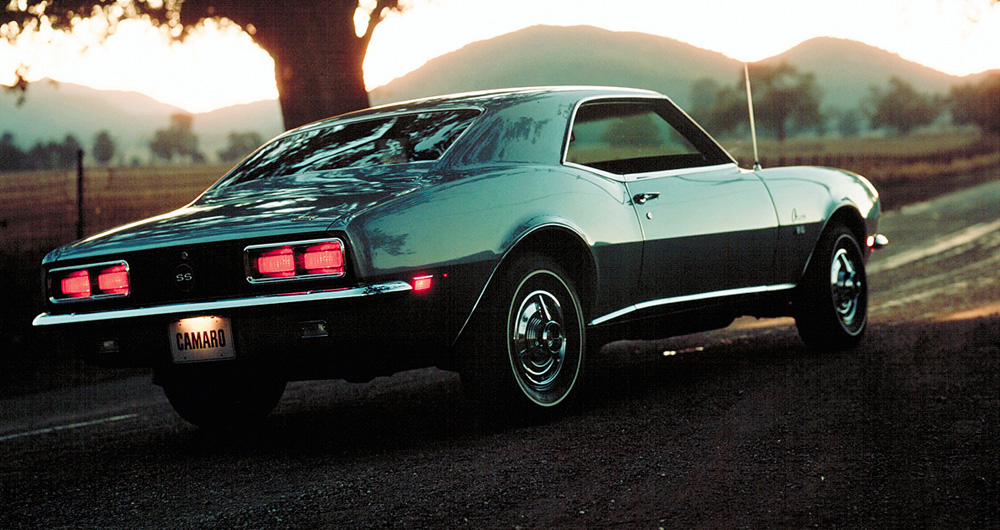
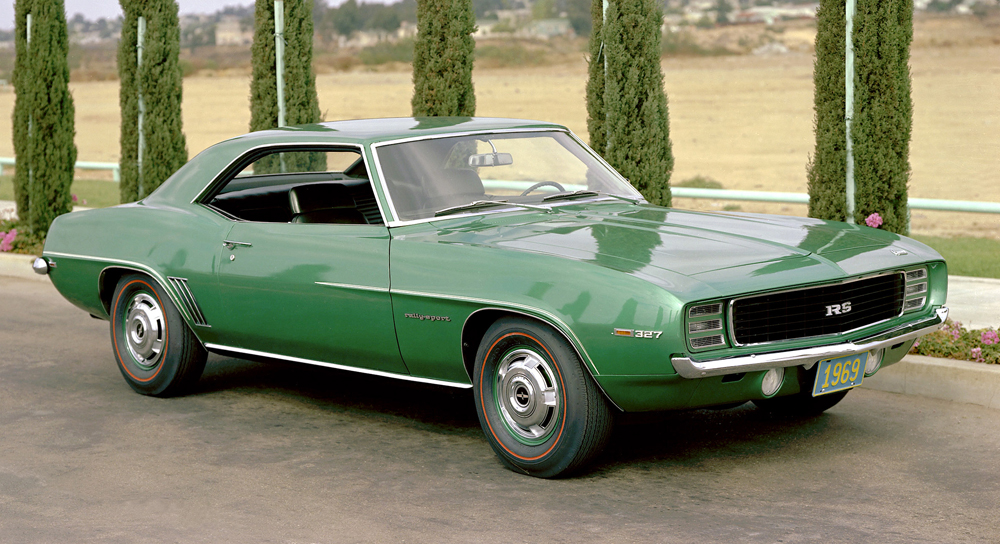
1969 Camaro
1969 Camaro Representing the final rendition of the first generation Camaro, the restyled ’69s raced through a year of remarkable accomplishments. While the Z28 with its high-revving 302-cid small-block V-8 raced to a Trans Am championship, specially produced ZL-1 Camaros with aluminum-block 427s provided thunderous thrills at the drag strips. Down in Indiana, a specially detailed SS/RS big-block 396 Convertible paced the 1969 Indy 500. Many collectors consider the ’69 the best of the gen-one Camaros, and a 1969 Camaro owned by Ed Welburn, vice president of GM Global Design, served as inspiration for 2010 forward-looking Camaro.
Look for: Rectangular wheel wells. Sculpted body-side “speed lines” trailing rearward from the wheel-well openings. Retractable body-color headlamp covers (RS package only).
The 1969 model year was exceptionally long, extending into November 1969, due to engineering problems that delayed the introduction of the second generation model planned for 1970. It is a popular myth late-’69 Camaros were sold as 1970 models (due to GM publicity pictures of the ’69 Camaro labeled as a 1970), but they were all assigned 1969 VIN codes. The proposed ’69 SS350, intended to address the delay, was instead sold as a ’70.
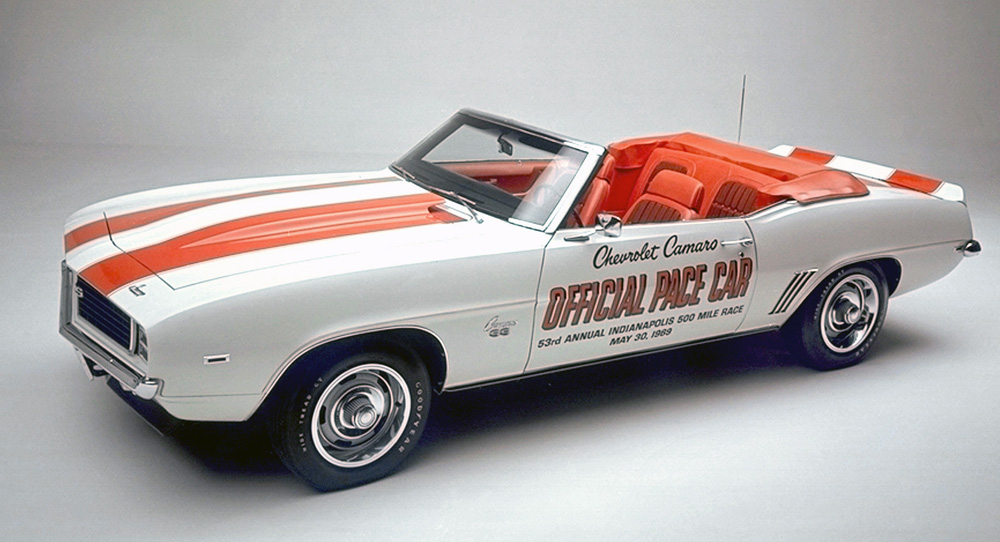
Providing a grand finale for the first-generation Camaro, the pleasingly refreshed 1969. included a Z28 model that ruled in Trans Am racing, and an Indy 500 Pace Car considered iconic today.
Boosted by Z28 popularity, Camaro enjoyed its greatest sales year yet in 1969. When Camaro was chosen as the official Indy pace car for the second time in three years, more than 3,500 replicas were sold by Chevy dealers throughout the country. The 1970 Camaro restyle widened the body look and added a long squarish grille and dual headlamps, bucking the industry trend toward quad treatments.
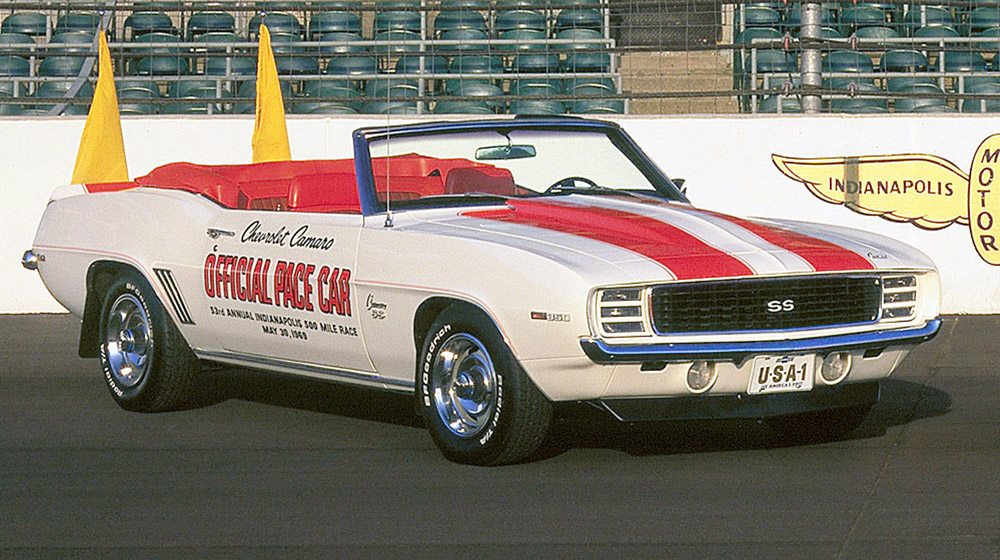

Providing a spectacular grand finale to the first generation (1967-69) Camaro, the freshly restyled ’69s raced through a year of unprecedented exhilaration. Chevy’s hot four-seat sportster was turning up at the head of the pack everywhere, it seemed. The Z28 was headed for a Trans Am racing championship, several dozen specially produced ZL-1 aluminum-engined Camaro coupes were providing thunderous thrills at drag strips, and a specially detailed RS/SS 396 Convertible popped up just in time to pace the 1969 Indy 500. No 1969 Camaro would ever become just another used car. The spirit of the now-iconic ’69 is subtly evident throughout the forward-looking 2010 Camaro.
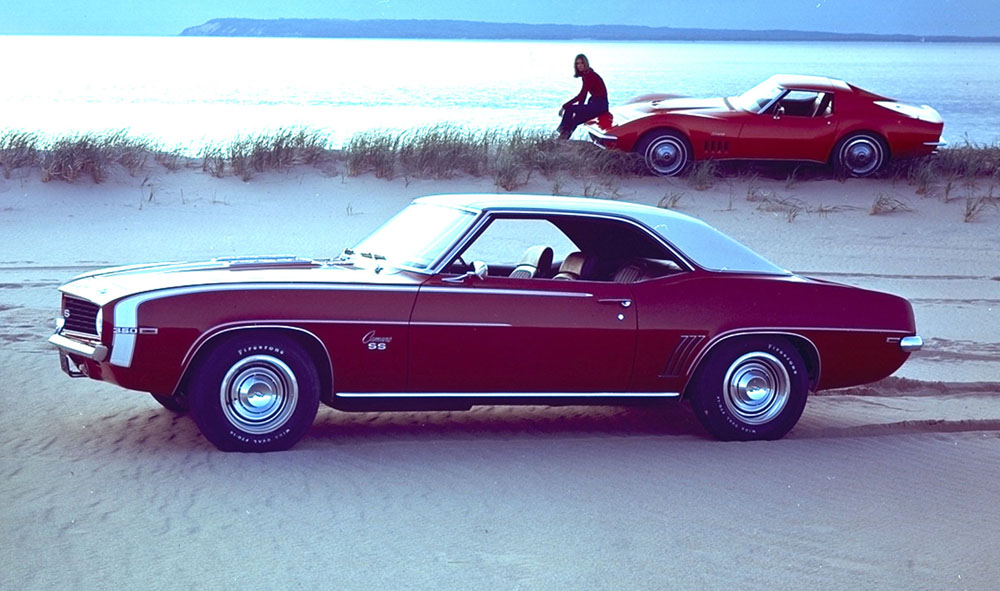


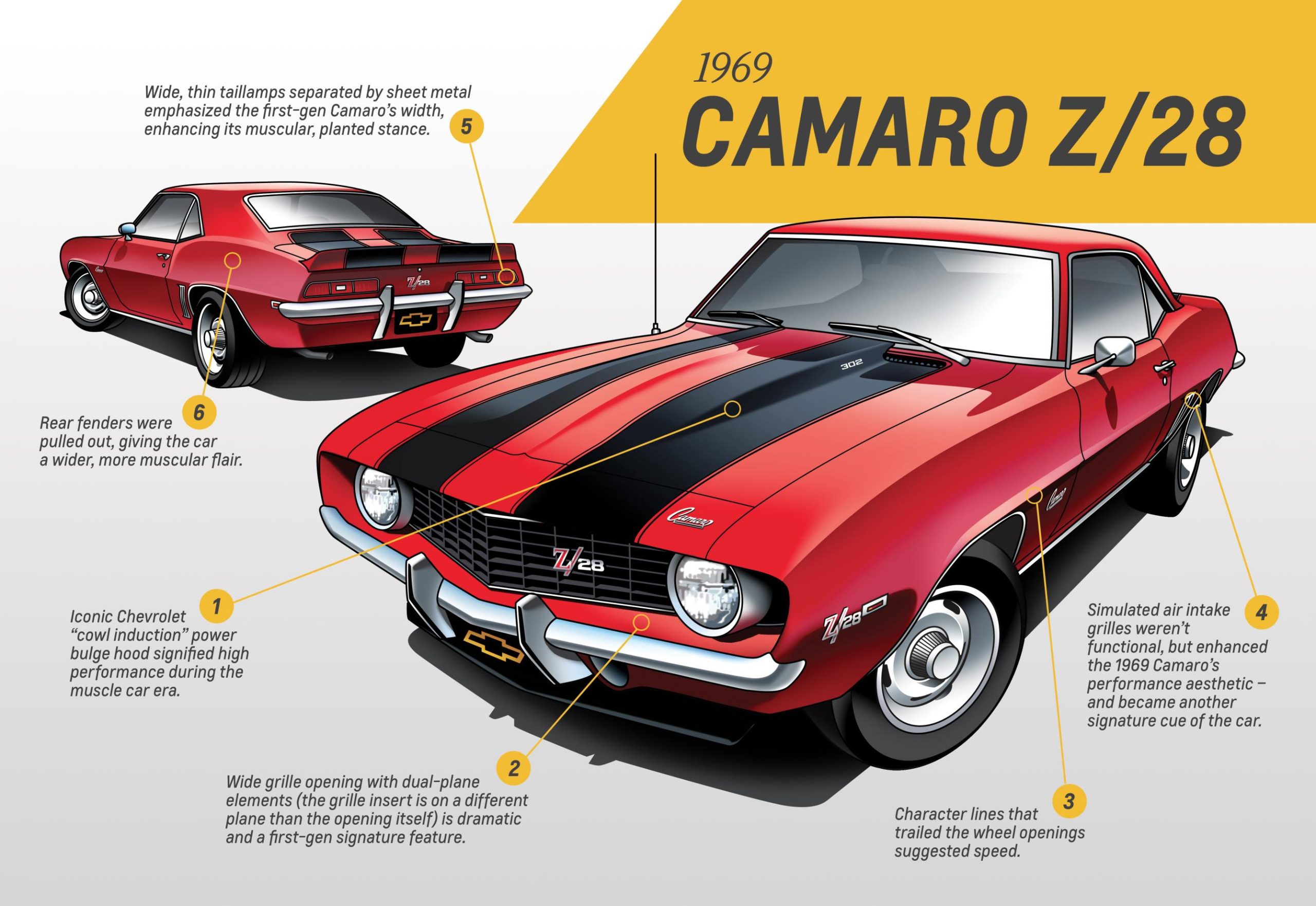
First Generation – 1967-69
The Camaro should not have been a design success, as it was based on an existing architecture and admittedly hurried to market to address the personal coupe revolution occurring with Baby Boomer customers. However, the first-generation Camaro delivered a pure, classic proportion that will forever be regarded as one of the best-looking cars of its time. It was very lean and muscular, with comparatively minor embellishments for high-performance models. That was in contrast to some of the brasher competitors during the muscle car era, and it has helped the first-generation Camaro maintain timeless good looks.
The Camaro’s first generation lasted only three model years. The 1969 model is the iconic Camaro, from the dual-plane grille design and speed lines stamped into the fenders and doors, it was original and distinctive.
highlights for the 1969 Camaro include:
- Every effort was made to make it appear wider, sleeker and more muscular
- Character lines that trailed the wheel openings gave the car an aura of speed
- The rear fenders were pulled out, giving the car a wider, more muscular flair
- Dual-plane grille added visual interest to the nose and became a trademark of Camaro design
- Wide taillights, with body-color sheet metal between them, exaggerated the car’s width
- Simulated grilles forward of the rear fenders provided accent detail and became one of the 1969 Camaro’s focal styling cues
- Chevrolet-signature “cowl induction” power bulge hood signified the muscle beneath it, from high-revving Small Block V-8 to high-torque Big Block V-8 engines

You must be logged in to post a comment.